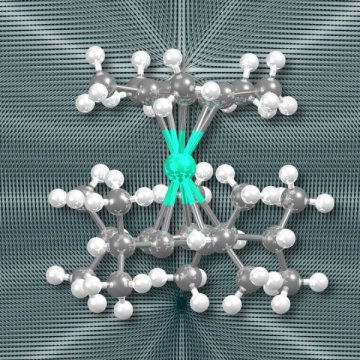[ad_1]
Single-molecule magnets are molecules capable of remembering the direction of a magnetic field that has been applied to them over relatively long periods of time once the magnetic field is switched off. Thus, one can “write” information into molecules. Single-molecule magnets have potential applications, for example, as high-density digital storage media and as parts of microprocessors in quantum computers. Practical applications have, however, been greatly hindered by the fact that single-molecule magnets are operational only at extremely low temperatures. Their intrinsic memory properties often vanish if they are heated more than a few degrees above absolute zero (-273°C); therefore, single-molecule magnets can be only studied under laboratory conditions by cooling them with liquid helium.
More favorable conditions for technological applications
Researchers have now, for the first time, managed to synthesize and characterize a single-molecule magnet which retains its memory properties above the temperature of liquid helium (-196°C). The magnet can be called the first high-temperature single-molecule magnet.
– When considering our everyday life, liquid nitrogen is extremely cold. However, compared to liquid helium, which has so far been required to study single-molecule magnets, the liquid nitrogen temperature is a huge leap upwards. Liquid nitrogen is more than 300 times cheaper than liquid helium and much more readily available, enabling technological applications. Therefore, the research constitutes an important scientific milestone, describes postdoctoral researcher Akseli Mansikkamäki from the Department of Chemistry of the University of Jyväskylä.
New insights from computations
The new dysprosium metallocene compound is the culmination of several years of research. The project has required the development of new approaches in organometallic lanthanide chemistry and deep insights of the relationship between the microscopic electronic structure and magnetic properties of the studied systems.
- Computational methods based on quantum mechanics and the theory of relativity play an important role in the characterization and design of new single-molecule magnets. The large computational resources available today have enabled, for example, to clarify the interaction between crystal vibrations and the electronic structure of molecules studied in the present work, Mansikkamäki explains.
The research also provides new insights and guidelines how to further improve the magnetic properties of single-molecule magnets and how to bring technological applications closer to reality.
Story Source:
Materials provided by University of Jyväskylä – Jyväskylän yliopisto. Note: Content may be edited for style and length.
[ad_2]















